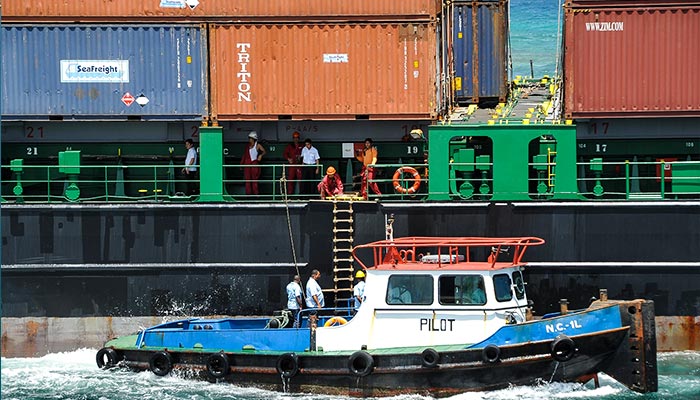Port Access Procedures
Safe and efficient port access is our highest priority. Berthing requests, pilotage, tug assistance are facilitated by professionals utilizing modern equipment; furthermore the customer is required to comply with the customs and immigration requirements.
Berthing Requests
Curaçao has a fully equipped control tower known as the Vessel Traffic Control Center (VTCC), situated at Fort Nassau in the Willemstad Harbor. The VTCC operates according to ISO standards since the beginning of 1999. All vessel traffic within our ports is planned and coordinated by the VTCC. Since Curaçao has five ports, the VTCC has no restrictions regarding the days of request. The berthing request is done by the shipping agent, who contacts the VTCC (channel 12) and provides the following information:
| Ship’s name | Purpose of visit |
| ETA | ETD |
| LOA/BOA | Last port |
| Draft at arrival | Port of destination |
| Gross tonnage | ISPS Security Level |
| Type of vessel |
The VTCC then provides a berth according to the purpose of the port visit and the specifications of the vessel. The agent will inform the captain of the details of the berth and report daily to the VTCC regarding (expected) arrivals, departures or shifts of vessels. The agent will also order tugboats according to the tugboat-regulations, except when an agent is not available, or in urgent cases when vessels may be in danger. Regulations determine a minimum of tugboat assistance for arriving, departing or shifting vessels.
Pilotage
Pilotage is compulsory for ships over 50GT. The pilots are employed by the Curaçao Pilotage Organization (CPO), which offers 24-hour pilotage services. A 100% overtime charge applies for pilotage between 18.30-05.30 hours. Discounts are offered to cruise vessels. Vessels must provide a lighted, manned, properly secured and clean pilot ladder fitted with sufficient spreaders. A life buoy fitted with a Holmes light and a reliable heaving line should be placed close to the pilot ladder. The embarkation and disembarkation must be supervised by an officer. Vessels arriving or leaving with a free board exceeding 30 feet must use the accommodation ladder in conjunction with the pilot ladder (Safety of Life at Sea Convention 1960). Vessels bound for Curaçao should proceed to Willemstad harbor except on orders for another bay. Vessels in VHF-range should contact Vessel Traffic Control Center (call Fort Nassau) on VHF channel 12 for further instructions.

Pilot Station
Vessels should stay one mile southwest of the harbor entrance to await pilot. Both anchors should be ready for immediate use. Defects of engines, steering gear, anchor gear and other defects which influence maneuvering abilities of the vessel must be reported to the harbor master before entering. Applicable ship certificates need to be present and valid.
Tug Assistance

To order a tugboat, the Fort Nassau Control Center should be contacted. Tugboats are dispatched by KTK Tugs. The company’s fleet consists of 9 tugboats. For more information on KTK Tugs and its tugboats please visit the website: www.ktktugs.com
Customs and Immigration

All vessels visiting the ports of Curaçao must comply with the Customs & Immigration requirements.
Immigration requirements:
- Two copies of a crew list.
- Two copies of a passengers list. Passenger lists should indicate full name, age, sex, civil state and occupation. Passengers must show proof of citizenship. A passport, voter’s registration or birth certificate is acceptable.
- Two copies of a health declaration sheet.
Customs requirements:
- One copy of the list of stores (deck, engine, narcotics, fire-arms and steward department).
- Manifest of cargo for Curaçao, in duplicate on a special form called “cargo list,” itemizing the cargo by lots of the same marks and showing numbers, kind of packages, general description of contents and weights in kilograms or pounds of each lot.
- Manifest of cargo, in transit, for transshipment through Curaçao to other ports, in duplicate, for each different port and separately.
- Manifest of cargo, on board, general description of the merchandise and total weight in kilograms or pounds if the cargo is in bulk, this should be indicated accordingly.
- Two copies of tally books of cargo for discharge at Curaçao.
- One copy of crew list plus one of personal effects list.
- One copy of lists of passengers embarking/disembarking in Curaçao.
- If the ship is in ballast, only the stores list is required.
Dangerous Cargo
The Port of Willemstad permits only limited quantities of explosives or other dangerous cargo, while the other ports allow calls with greater quantities. All vessels carrying explosives or other dangerous IMO cargo, for discharge in Curaçao, transshipment or in transit without transshipment, require special permission in writing before entering any port of Curaçao.
The ports of Curaçao uphold several forms and international regulations concerning the transportation of dangerous cargo, explosives, gasses, ammunition, radioactive material, poison, flammable substances, inflammable solid materials, oxidizing elements and other materials as mentioned in the International Maritime Dangerous Goods-Code (IMDG-Code). The entry permit required for vessels carrying dangerous and/or hazardous cargo consists of legal dues plus stamp and is handed out by the harbor and safety inspection office. At the discretion of the Harbor Master, a special guard may be assigned on board vessels handling or having dangerous and/or hazardous cargo on board.

